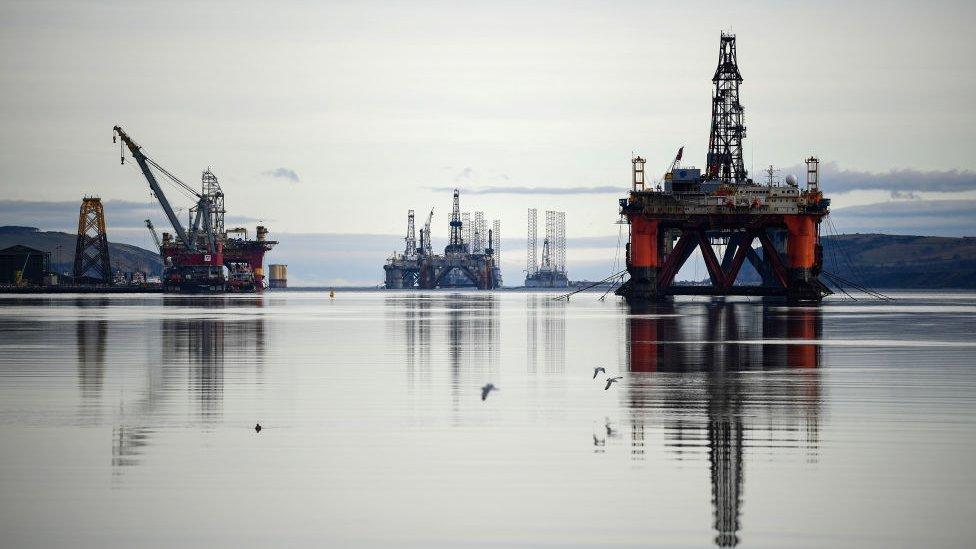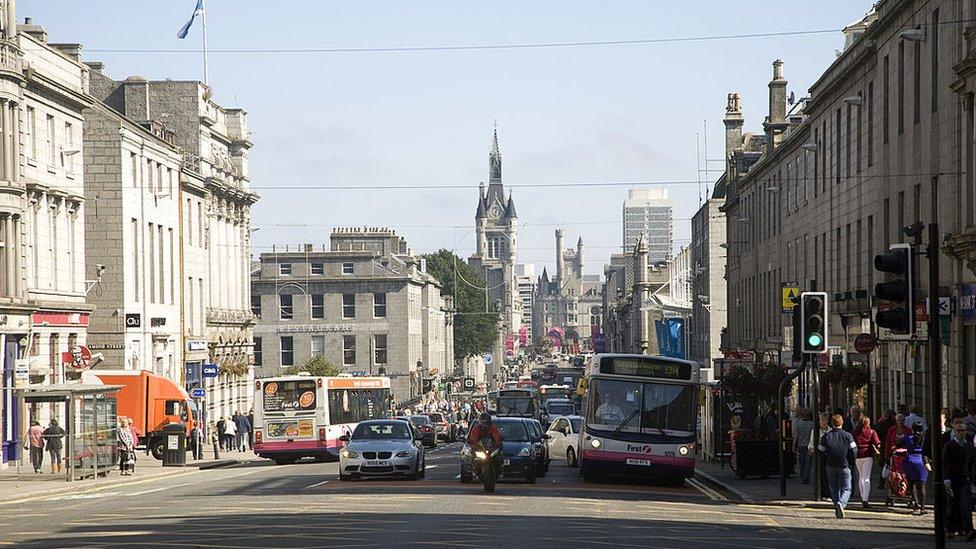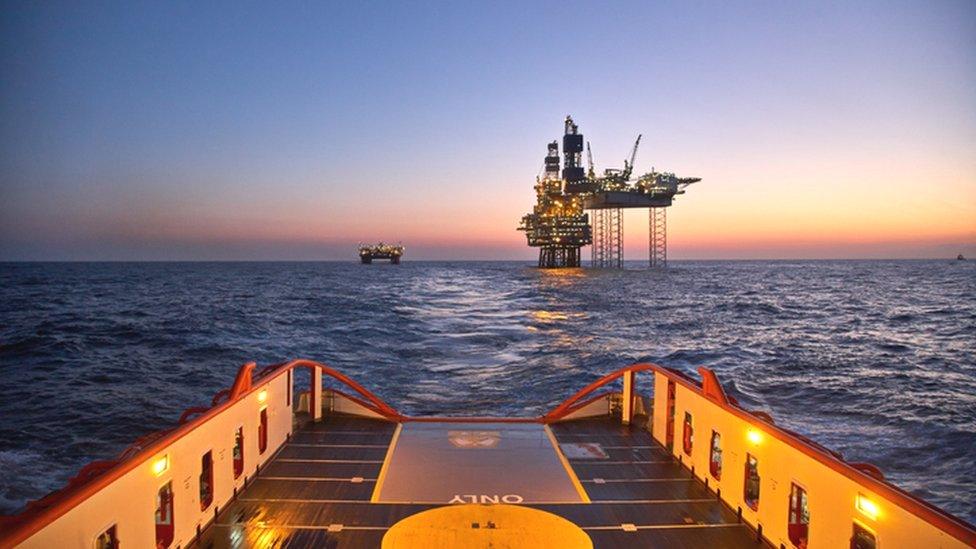IFS report: Where are Scotland's inequalities?
- Published

Oil and gas is important to the Highland economy as well as to the north-east.
Unequal income shapes perceptions of Scotland's economic health, and a wealth of new analysis has just dropped, from the Institute for Fiscal Studies (IFS).
The report highlights regional inequality within Scotland, as its most prosperous areas are slowed up by the oil and gas industry that has fuelled their local economies.
It also looks at the gaps between high and low earners. While Scotland has less poverty and less inequality than its southern neighbour, that difference has been eroding.
You don't hear much about 'levelling up' within Scotland.
It's a Whitehall term, dating back a couple of prime ministers. A political project to close the gulf of opportunity between London and its prosperous south-east neighbours and the parts of the country which feel - in many cases rightly - that they have been left behind.
Some of the funds reach Scotland with a union flag prominently attached but most of the political project is aimed at parts of the north of England.
England is a large and populous country with a sprawling confusion of weak local governance and that makes the devolution of power and distribution of funds a big task.
In Scotland, we haven't heard so much about devolving power out from Holyrood.
Perhaps it's because of the party in government. The clue is in the name. They are not just the Scottish party but the Scottish National Party.
Sixteen years ago, the party's approach to local government began with Alex Salmond triumphantly signing an 'historic concordat' of mutual respect with councils. This was intended to be a contrast with the Labour-Liberal Democrat coalition years, when Holyrood had difficult relations with local councils. The agreement also brought in the freeze on council tax rises.
The SNP government then applied the harshest squeeze of the austerity years to local authority budgets. That came with a return to ring-fencing for Nicola Sturgeon's priorities such as childcare.
Under Humza Yousaf, the relationship has returned to an agreement on councils being treated with more respect, with less ring-fencing of budgets, an "expectation" that services will be "delivered at a local level unless agreed otherwise", and periodic reviews of council powers.
Playing catch-up
The role of Holyrood in funding councils is partly to equalise across them, securing an equivalent level of public service whatever the tax base.
Aberdeen and Aberdeenshire complain they have long come out of that badly.
It's one reason the city centre has not benefited from the same regeneration and modernisation funds as poorer council areas to the south. Hence, the disputed efforts to catch up in Union Terrace Gardens and Union Street.

Aberdeen has not benefitted from urban regeneration funds
Now, the Institute for Fiscal Studies (IFS) has provided evidence that the north east has a case for more help from St Andrew's House in Edinburgh.
The region's relatively high employment and high earnings, fuelled by oil and gas, have slowed closer to Scotland's average. Hourly pay was once 30% higher than the Scottish average but the last decade has seen that drop to a 14% premium.
The Highlands and islands have many pockets of employment in offshore work but it has not been doing as well as those on the other side of the Spey. Average hourly pay, which was 6% below the national average, has fallen to leave a 10% shortfall.
Dumfries and Galloway has not had the same energy boom as the north, nor the benefit of as much infrastructure spending. It ranks as the lowest-paid council area in Scotland. At £16.10 per hour, that's around £2 below average, and £10 below the highest paying area, East Renfrewshire.
The IFS story is about Scotland playing catch-up with the rest of the UK. And if you exclude London as an outlier because it distorts such figures with super-high pay for financiers, lawyers and oligarchs, much of Scotland has in fact grown to match the UK over the earlier parts of the past two decades.
From 2002 until around 2014, Scotland was catching up at a healthy pace. That stalled around 2014, when the global oil price tanked and both jobs and pay in the offshore industry also took a dive.
They've only partially recovered in the past three years of spikes and volatility and remain constrained both by uncertainty about the UK tax regime and the political uncertainty as to whether a new burst of investment will be encouraged or discouraged by Downing Street after the next election.
The IFS says all of the slowing up of Scotland's national earnings growth can be explained by the slowing up of the nation's north and north east.
Its analysis has positive things to say about some of those parts of Scotland which have struggled out of de-industrialisation in recent decades.
West central Scotland has done a lot of catching up in employment and earnings. It's been clear since at least the start of the century, even as oil and gas production declined, that Scotland was no longer the poor relation of the United Kingdom but in many ways typical of its economic performance. The IFS analysis underlines that.
Conundrum
The report also puts a spotlight on poverty and differences in income inequalities, which have been flagged up as a top priority for Humza Yousaf.
Scotland has had lower measures of inequality than the rest of the UK - in other words, it's less unfair - but drawing on data from before the pandemic, it was moving closer to the UK position.
The household close to the top of the Scottish earnings spectrum (technically, the 90th percentile) has recently had income 5.7 times more than the person equally close to the bottom. The comparable figure for the UK peaked above a seven-fold multiple of earnings, before falling slightly.
Taking those two people as examples is intended to strip out the distorting effect at both extremes.
The most recent available figures show less of a gap in Scotland between middle and high earners than in other parts of Britain but a similar gap between middle earners and those on the lowest income.

Food banks have become a sign of growing poverty
Scotland's level of poverty, at 19%, is reckoned to be around three percentage points lower than the average south of the border.
Much of this is explained by housing costs. Scotland has a significantly higher share of renting households in social housing than the rest of the UK (59% to 45%) and those in social rented housing are paying lower rents than those south of the Border.
The report uses statistics from 2017 to 2019 to show the proportion of children in relative poverty at 24% compared with 30% in the rest of the UK.
It signals that future studies can expect to see an impact on the poverty figures from that £25 weekly Scottish Child Payment for those on lower income, which was increased and expanded less than a year ago.
But it warns the Scottish government of limits to its largesse with welfare benefits, and also limits to the returns on increased tax rates for higher earners.
Scottish government has been focussed on that sort of inequality and less so on the geographical variety.
But of course, politics comes back into this when elections loom. And politics is geographical.
While the SNP is fighting to retain seats across Scotland, the IFS highlights what it calls "a conundrum".
Scotland's levelling up challenge is whether to focus more attention on helping parts of Scotland that have slowed but remain relatively well off, or on those that have been catching up but remain worse off and which are still recovering from the decline of older industries.
- Published9 August 2023

